GP57
| Location: Richardson Hill | Aust. Soil Class.: Humose, Eutrophic, Red CHROMOSOL |
| General Landscape Description: Crest of a low hill | Geology: Tertiary basalt. |

GP57-GP60 Landscape
Soil Profile Morphology:
Surface Soil
| A1 | 0-25 cm | Dark brown (7.5YR3/3); fine sandy clay loam; moderate to strong coarse polyhedral, parting to strong fine polyhedral structure; weak to firm consistence dry; basalt fragments common (15-20%); pH 5.4 | 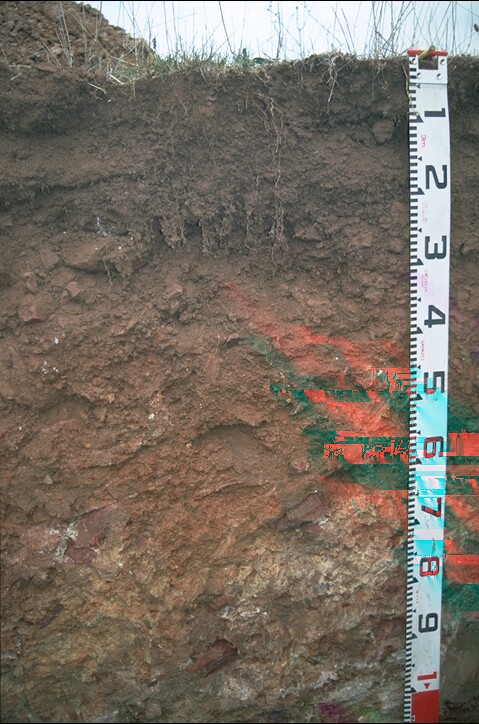 GP57 Profile |
| Subsoil | |||
| B1 | 25-40 cm | Reddish brown (5YR4/4); light clay; strong medium polyhedral, parting to fine structure; weak to firm consistence dry; contains many (40-50%) basalt fragments (2-10 cm in size); pH 6.1 | |
| B21 | 40-65 cm | Yellowish red (5YR4/6); medium heavy clay; strong medium polyhedral, parting to fine polyhedral structure; pH 6.1 | |
| B22 | 65-110 cm | Pale red (2.5YR7/4) with yellowish red (5YR5/8) mottles; medium clay; moderate polyhedral, parting to fine lenticular structure; contains kaolinitic material; pH 5.0 | |
| BC | 110+ cm | Light Grey (N7) with dusky red (2.5YR4/4) mottles | |
Key Profile Features:
- Contains large amounts of basalt within the surface (A1) and subsurface (B1) horizons.
- Vertic properties present within the subsoil i.e. lenticular structure.
pH | Salinity Rating | |||
Surface (A1 horizon) | Strongly Acid | Low-Moderate | Non-Sodic | None |
Subsoil (B21 horizon) | Slightly Acid | Very Low | Non-Sodic | None1 |
Deeper subsoil (at 90 cm) | Strongly Acid | Very Low | Non-Sodic | None |
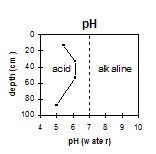 The surface horizon is strongly acid. The subsoil is slightly acid becoming strongly acid with depth. | 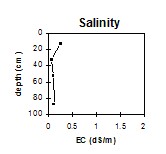 The salinity rating in the surface soil is low to moderate. The subsoil is very low. | 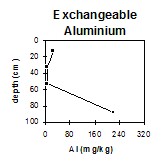 The exchangeable aluminium levels in the surface are low. At 55 cm depth the levels increase and become very high at depth. | 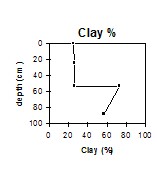 The clay content increases markedly at the A/B boundary. |
Horizon | Horizon Depth | pH (water) | pH CaCl2 | EC 1:5 | NaCl | Exchangeable Cations | |||
Ca | Mg | K | Na | ||||||
Meq/100g | |||||||||
A1 | 0-25 | 5.4 | 4.9 | 0.25 | <0.03 | 11 | 3.7 | 1 | 0.3 |
B1 | 25-40 | 6.1 | 5.2 | 0.07 | 5.8 | 3.9 | 0.4 | 0.48 | |
B21 | 40-65 | 6.1 | 5.3 | 0.1 | 4.6 | 6.1 | 0.29 | 0.76 | |
B22 | 65-110 | 5 | 4.3 | 0.11 | 0.92 | 3.8 | 0.1 | 0.59 | |
Horizon | Horizon Depth | Ex Al mg/kg | Ex Ac meq/100g | Wilting Point pF4.2 g/100g | Coarse Sand (0.2-2.0mm) % | Fine Sand (0.02-0.2mm) % | Silt (0.002-0.02mm) % | Clay (<0.002mm) % |
A1 | 0-25 | 25 | 21 | 23.3 | 17 | 15 | 27 | 25 |
B1 | 25-40 | <10 | 15 | 16.1 | 31 | 19 | 17 | 26 |
B21 | 40-65 | <10 | 13 | 26.3 | 4 | 9 | 10 | 73 |
B22 | 65-110 | 220 | 6.4 | 26 | 17 | 11 | 13 | 57 |
Management Considerations:
Surface (A) Horizon
- The surface (A1) horizon is strongly acid. Levels of exchangeable aluminium measured are not high (i.e. 25 mg/kg). A pH/aluminium test sampled across the paddock would be appropriate to determine whether lime is needed to raise soil pH. However, other factors need to be considered before lime is recommended (e.g. pasture species grown, method of application, local trial responses, soil surface structure and likely cost/benefit).
- The inherent fertility of the surface (A1) horizon (based on the sum of the exchangeable calcium, magnesium and potassium cations) is moderate. The very high levels of organic matter at this site are important for improving soil fertility, water holding capacity and enhancing surface soil structure. The nitrogen levels are also very high. Planting legumes may help to alleviate the low fertility deficiency.
- The level of soluble salts in the surface is low to moderate and may restrict the growth of salt sensitive species (e.g. faba beans, linseed, chick peas and lupins). Roots for the current plant species were observed to 60 cm depth.
- The subsoil has a moderate inherent fertility throughout (based on the sum of the exchangeable basic cations).
- The presence of mottling throughout the subsoil indicates that the profile is seasonally waterlogged.
- The subsoil has vertic properties i.e. lenticular structure which indicates that significant shrinking and swelling occurs during wetting-drying cycles. This can disrupt the roots of perennial plants and will have implications for engineering applications (e.g. building foundations and fence lines).
- Contains a common (40-50%) amount of basalt only within the upper subsoil...............
- At 65 cm depth the soil becomes strongly acid and the exchangeable aluminium levels very high at 220 mg/kg. However, only deep rooted plants would be effected.


